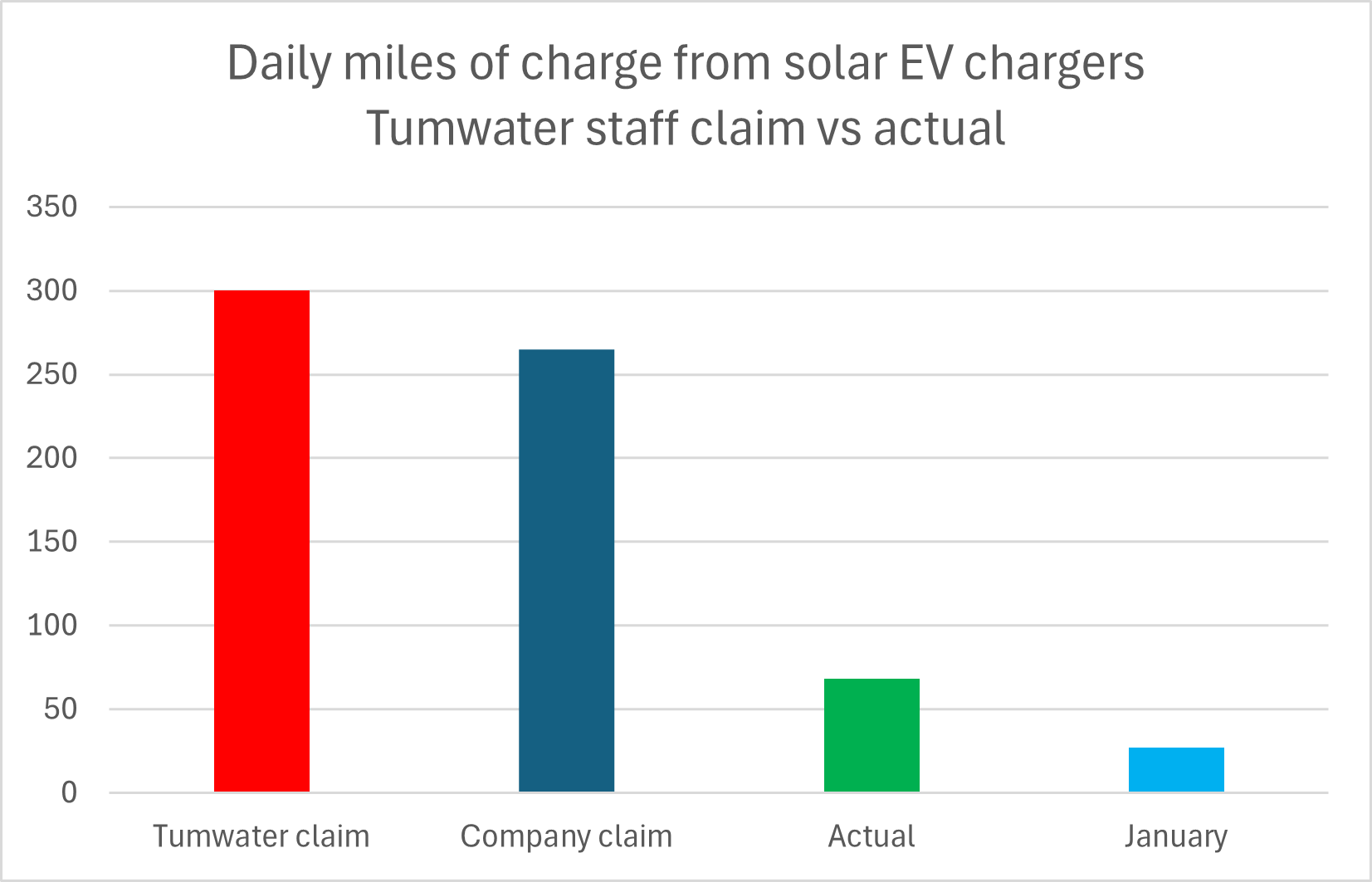What do taxpayers get if cities match an extremely inefficient source of power with expensive (and unnecessary) electric vehicle chargers? The City of Tumwater and a few other cities are finding out, installing solar-powered EV chargers at parks and other locations. The chargers are about five times as expensive as installing grid-connected chargers and they produce far less electricity for users.
The solar-powered chargers are yet another example of incredibly wasteful government spending justified in the name of fighting climate change even as they do virtually nothing for the planet.
While the number of solar-powered chargers in the state is still small, it is a case study in the frivolous way that money intended to reduce CO2 emissions is being wasted.
Earlier this year, the City of Tumwater announced it was installing a solar-powered EV charger at a city park. The city received a grant of $87,052 to install the system, which can charge two cars at once. The city added another $12,742 for a total of $99,794.
What does the city get for that? Very little.
At the city council meeting to approve the expenditure, Tumwater’s sustainability manager Alyssa Wood said, “I will admit that through my entire career, I have been trying to get this unit.” She went on to claim that the solar-powered EV charger “is expected to give about 300 miles of charge every day.” This is completely inaccurate.
The company that makes the chargers claims they can only provide “up to 265 e-miles” per day. That is under the best circumstances – in a sunny part of the country during the summer. Wood’s testimony exaggerated even the company’s highest estimate.
The real amount is far lower because Washington’s weather is so poor.
Western Washington is one of the worst places in the United States to generate solar power, according to the National Renewable Energy Laboratory (NREL). Using NREL’s calculator to estimate the amount of energy generated by the charger’s solar panel shows just how poor it is.
Using the default settings on NREL’s PVWatts calculator indicates the charging station’s 5.76 installed kW panel will generate about 6,170 kilowatt hours (kWh) of electricity annually that could be stored in the system’s battery. That is about 30 percent less than the same system in Phoenix.
That amounts to an average of between 56 and 68 miles per day depending on whether the vehicle is a Nissan Leaf or a Tesla 3. A larger electric vehicle, like the Rivian SUV, would get only 37 miles on the average amount of charge.
 Depending on the time of year, those numbers change significantly. The best month is July, when it can charge an average of 110 miles a day for a Tesla 3. This is still about a third of what Tumwater city councilmembers were promised. Right now, in October, that falls to 53 miles. In January, it is only 24 miles.
Depending on the time of year, those numbers change significantly. The best month is July, when it can charge an average of 110 miles a day for a Tesla 3. This is still about a third of what Tumwater city councilmembers were promised. Right now, in October, that falls to 53 miles. In January, it is only 24 miles.
Real-world use is even less than that.
Bellingham has four solar-powered EV chargers. For the first 100 days, between May and August, they delivered an average of just 6 kWh per charger. That is just 24 miles of charge per day for a Tesla, or just 20 miles for a Leaf.
Bellingham city staff estimate that during that period of time the four chargers reduced greenhouse gas emissions by 1.8 metric tons of CO2. I am skeptical of that claim because it assumes that without those four chargers, people would have used gasoline instead. That is almost certainly false. The real amount of CO2 avoided is probably zero or close to zero.
Assuming, however, that city staff are right, that same amount of CO2 could have been avoided by investing $18 in projects that reduce emissions, or $66 annually. Even if we use Washinton state’s inflated and questionable Social Cost of Carbon – the amount of damage one metric ton of CO2 purportedly does – of $96 per MT/CO2, the value of the CO2 damage avoided by the chargers is only $631.07. That is the highest possible amount of environmental benefit that could be delivered by these chargers. At that rate, it would take 475 years to deliver environmental benefits equivalent to the approximately $300,000 value of the four chargers.
Bellingham is doing more harm than good by wasting money on solar chargers that do little to nothing to reduce CO2 emissions.
It is notable that Tumwater’s solar-powered EV charger cost about $100,000 in state and local funds – even more than Bellingham. It would take 634 years to avoid the amount of CO2 to make the expenditure worthwhile for the environment at the state’s extremely inflated CO2 cost.
And, again, the likely amount of CO2 actually avoided is zero, meaning that money does nothing for the planet.
Like those in Bellingham, Tumwater’s charger is in a park. While it is probably nice for EV owners to be able to charge while they are in the park, it is unlikely that the charge is necessary for them to get home. It is a luxury, not a necessity.
One city facilities director I spoke with said that grid-connected EV chargers cost about one-fifth the cost of the solar-powered chargers. Why pay so much more for the solar-powered chargers, then? He told me the city council thought it would be nice to have the power come from the sun. That is an indefensible waste of money – not to mention the opportunity to use that money for things that would actually help the planet or people.
This is a relatively small amount of money in the larger picture. However, these are the types of projects that accumulate and amount to significant waste. And if these types of brazenly wasteful projects aren’t stopped, they become the norm.




